The Brazos Performance Preview: AMD E-350 Benchmarked
by Anand Lal Shimpi on November 16, 2010 12:01 AM ESTMemory and Cache Latencies
The Brazos platform was configured with 4GB of DDR3-1066 memory. The IDF system had memory running at DDR3-1333, however AMD had to decrease clocks presumably to meet validation requirements for final silicon. I measured an 86.9ns trip to main memory, a 3 cycle L1 and a ~22 cycle L2 cache. That's a lower latency memory interface than Atom or Core 2 based processors, but a higher latency L2.
CPU Performance: Better than Atom, 90% of K8 but Slower than Pentium DC
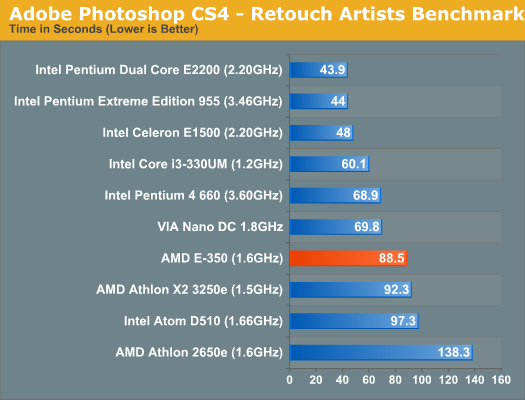
AMD's performance target for Bobcat was 90% of the performance of K8 at the same clock speed and our Photoshop CS4 benchmark shows that AMD can definitely say that it has met that goal. At 1.6GHz the E-350 manages to outperform a pair of K8s running at 1.5GHz in the Athlon X2 3250e. Unfortunately for AMD, Intel's Pentium dual-core running at 2.2GHz is much quicker. Most notebooks in the $400+ range have at least a 2.2GHz Pentium. Even the Atom D510 isn't far behind.
AMD tells me that in general purpose integer tasks, the E-350 should do well and it may even exceed AMD's 90% design target. However in higher IPC workloads, for example many floating point workloads, the E-350 is constrained by its dual issue front end. In these situations, the out of order engine is starved for instructions and much of Bobcat's advantage goes away.

Our x264 HD test has the E-350 performing within 86 - 92% of the Athlon X2 3250e, once again meeting AMD's design targets. Unfortunately, this isn't much faster than an Atom - mostly thanks to Atom's Hyper Threading support. Although not an out of order architecture, Atom gets a healthy efficiency boost by being able to execute instructions from two threads per core. Once again, compared to a 2.2GHz Pentium, the E-350 isn't close. Even VIA's dual core Nano is faster. When it comes to power consumption however, the E-350 can't be touched. I measured max system power consumption at 25.2W while running the x264 encode test. With the exception of the Atom D510, the rest of the desktop platforms here consume much more than that at idle (much less under load).
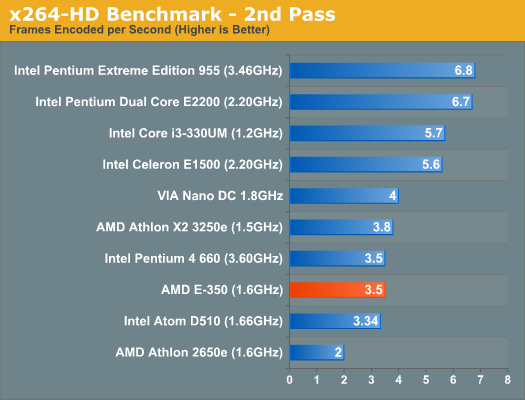
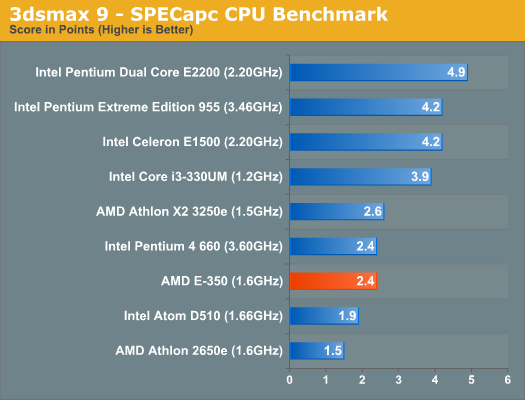
Despite being a offline 3D rendering benchmark, our 3dsmax 9 test does fall in line with expectations. The E-350 delivers 92% of the performance of the Athlon X2 3250e and outperforms the Atom D510 by 26%. Unfortunately for AMD, the Pentium dual-core holds onto a significant performance advantage here. Clock for clock, Bobcat won't be able to do much against anything Core 2 based. The real advantage here will be GPU performance.
Single Threaded Performance
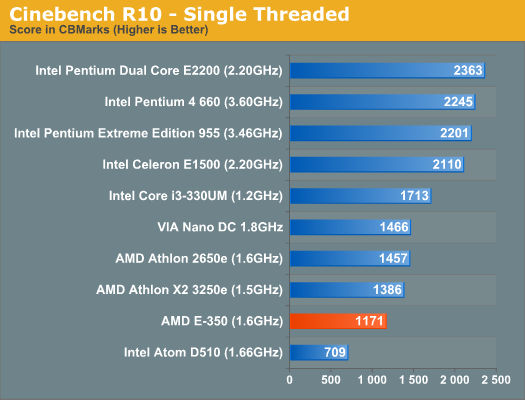
In most of our benchmarks the performance advantage over Atom isn't huge, yet using Brazos is much better than using an Atom based machine. It all boils down to one thing: single threaded performance. Atom can make up for its deficiencies by executing a lot of threads in parallel, but when you're bound by the performance of a single thread the E-350 shines. The E-350 is 65% faster than the Atom D510 in the single threaded Cinebench R10 test. It's this performance advantage that makes the E-350 feel so much quicker than Atom.
The Core i3-330UM manages a 46% performance advantage over the E-350. Even in the ultraportable Arrandale ULV space at lower clocks, AMD still leaves a lot of CPU performance on the table. The advantage here will be cost. A single E-350 is less than 40% of the die area of a Core i3-330UM. You may not get the same CPU performance, but performance per mm^2 is much higher.

In the multithreaded Cinebench test Atom is able to catch up quite a bit, but the E-350 still holds an 11% advantage.
File Compression/Archive Recovery Performance
Our final two CPU tests are both multithreaded and they show the E-350 equaling and falling behind the performance of the 1.5GHz Athlon X2. As we explained earlier, the gap between the E-350 and Atom shrinks as you add more threads to the workload.
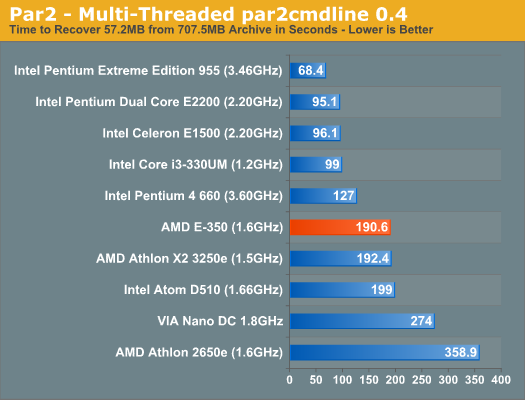
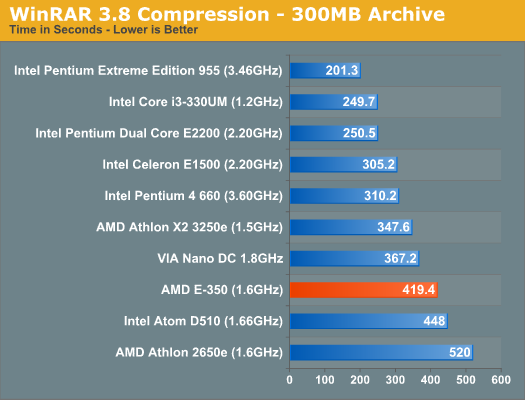










207 Comments
View All Comments
duploxxx - Tuesday, November 16, 2010 - link
TDP doesn't mean real world power consumption, I think you should look at a few other reviews first who did a better compare.... Zacate even owns atom 525 big time with ION and even better then single core atom.... what TDP again? :)http://hothardware.com/Reviews/AMD-Zacate-E350-Pro...
NST - Tuesday, November 16, 2010 - link
No, it isn't.E-350 has the same number of cores as I7-680UM(top of the line Intel CULV Processor that is supposedly available but nowhere to be found), higher frequency, better IGP and it comes at a far cheaper price.Also, Sandy Bridge, at its launch, won't bring new CULV chips, because the current line has been out for less than 6 months.So, no more competition for this segment.
8steve8 - Tuesday, November 16, 2010 - link
NST im not sure what your point is, yes the E350 has the same number of cores and the same TDP as all core i3/i5/i7 ULV parts, I'm not sure about price but they can be found in a variety of laptops, from the lenovo u160,u260,u460s, .... well almost every mfgr has a shipping laptop with a core iX ulv part (sans apple).laptops with these parts have been purchasable since june, and the e350 is only benchmarkable via an engineering platform... so its not exactly that close to market... even if it was.. seems like it can't compete vs core ix ulv. on anything other than price.
maybe if its super-cheap, it'll sell in a few netbooks vs atom.
NST - Tuesday, November 16, 2010 - link
1. E-350 has much better power consumption.2. E-350 has better GPU performance.
3. Intel CULVs are based on a better architecture however, E-350 has a higher frequency, which is crucial for 720p gaming.
As a gamer, what I see here is the potential for ultraportable notebooks with gaming performance close to this of Alienware M11x and never before seen battery life at the cost of an Atom-based netbook.
I do not question Intel's current supremacy in every segment but I think that next year Intel will face some strong competition from AMD.And that's good for us customers.
mino - Tuesday, November 16, 2010 - link
And you forgot the most important point - Brazos is playing in a completely different price bracket.The Atom price bracket.
Dark_Archonis - Tuesday, November 16, 2010 - link
Brazos is aiming at the $300-500 market. Guess what, there are some Celeron systems that fall in that price bracket as well.8steve8 - Tuesday, November 16, 2010 - link
1. does it have much better power consumption? the tdp's are the same, ive yet to see ulv arrandale vs e350, total system power consumption.2. yes, it has better gpu performance
3. the e350 has higher non-turbo frequencies than ulv arrandales, but why do you think that's crucial for 720p gaming... by that logic the 3.6Ghz pentium 4 is better suited for gaming than a 3Ghz sandy bridge cpu... which is false.
NST - Wednesday, November 17, 2010 - link
1.All you got to do is check the review of a laptop featuring an Arrandale ULV chip and then compare the power consumption.There plenty out there.Plus AMD stated that E-350's idle power consumption would be even lower in the final product.3. 720p gaming--->More CPU dependant
1080p, 1600p etc--->More GPU dependant
Generally about gaming, in higher resolutions, GPU becomes more and more important than the CPU.What I meant was that in a game that utilizes 2 cores E-350 will have an edge due to the higher frequency.And yes, if you find a game that utilizes only one CPU core (probably an old one) the Pentium will probably manage to hold his own against Sandy Bridge.
Khato - Wednesday, November 17, 2010 - link
1. How about the ~10W consumption of the Alienware M11x R2 while running the Anandtech Internet battery life test? That's a i7-640UM that'll ramp up to 2.27GHz when it's needed.With respect to other power consumption figures... It's mildly annoying how other sites are typically comparing desktop/'nettop' systems to the 'brazos' demo platform. After all, take a look at the power consumption of any actual notebook/netbook implementation of the same processors and suddenly the power consumption numbers of the 'brazos' demo platform is simply in line/above the competition rather than far below it...
If interested in other power numbers, the Anandtech "Intel Core 2 CULV Roundup" published earlier this year has some good figures for both atom and CULV. For example, the Asus 1005PE with the single-core atom N450 at 1.66GHz consuming a massive 9.5 watts under 100% CPU load. So theoretically an N550 with its 3 watt higher TDP would get up to all of 12.5 watts... Of course more interesting is the fact that the 1.3GHz CULV notebooks in that review are at all of 19 watts under 100% CPU load - so comparable power consumption, despite being faster and on a 45nm process tech instead of 40nm (though the Intel 45nm is roughly equal to TSMC 40nm, if not better.)
mino - Tuesday, November 16, 2010 - link
Do you see those ULV chips selling for Atom prices as Zacate and Ontario are ?You are comparing an enduro to a moped while complaining the latter is slower.
Hell it is. IT IS SUPPOSED TO BE.
The fact that Zacate is actually considered an alternative to ULV series at 1/3 the cost is a HUGE success on itself.